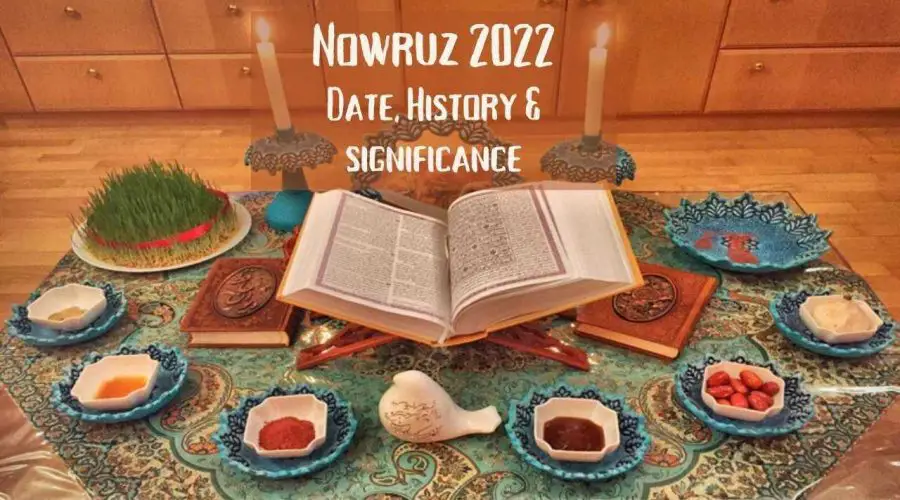About You need to know about Nowruz 2022 | Its History, Significance, and Celebration
Article Rating
☆☆☆☆☆ 3.9/5
Nowruz, also known as Navroz, is an Iranian New Year that marks the start of the spring season. It is observed with great zeal and passion by numerous Parsi groups around the world, including India.
The words ‘now’ and ‘ruz’ imply new and day, respectively, resulting in the phrase ‘a new day.’ Nowruz is the first month of the Solar Hijri calendar, and it is traditionally observed on March 20 or 21 around the world. People clean their houses, buy new clothes, and cook a lavish meal for their family and friends on this occasion, which is considered an essential day to do good deeds and utter kind words.
Nowruz 2022 Date
Monday, 21 March
History behind Nowruz
Nowruz is named after Jamshed, the Persian ruler who is credited with inventing the Persian or Shahenshahi calendar. Jamshed, according to tradition, protected the world from an impending catastrophe that took the form of a winter and was intended to kill everyone. According to the texts, there was no severe heat or cold, no premature deaths, and everyone lived peacefully in King Jamshed’s dominion. It is reported that the celebration was brought to India by Nusservanji Kohyaji, a wealthy trader from Surat in the 18th century who frequently travelled to Iran and began celebrating Nowruz in India.
In which countries is Nowruz observed?
Many countries with substantial Persian cultural influence, such as Iran, Iraq, India, Afghanistan, and parts of Central Asia, celebrate Nowruz. Kurds in Iraq and Turkey, as well as Iranians, Shias, and Parsis in the Indian subcontinent and in the diaspora, celebrate Nowruz. Nowruz is also observed by Iranian communities in the Americas and Europe, notably Los Angeles, Phoenix, Toronto, Cologne, and London. Nowruz is known as the Persian New Year Festival in Phoenix, Arizona.
India’s Nowruz celebrations
Nowruz is celebrated by the Parsi community in India around August 16-17, according to the Shahenshahi calendar, which does not account for leap years, hence the holiday has migrated by 200 days from its original date. Many people, however, commemorate it in March.
Patra Ni Macchi, Akoori, Falooda, Dhansak, Ravo, Sali Boti, and Saffron Pulao are some of the typical Nowruz foods
How is Nowruz Celebrated ?
Parsis dress up in traditional garb, decorate their homes with lights and rangoli, and cook delectable dishes. They host parties in their houses and pay visits to their loved ones. On this auspicious day, Parsis also visit the Fire Temple and offer fruits, sandalwood, milk, and flowers to the fire. Bonfires, feasts, musical performances, poetry readings, and traditional sports are all part of community celebrations.
Frequently Asked Questions
1. What is Nowruz and why is it celebrated?
The Iranian religion Zoroastrianism gave birth to Nowruz, which means “New Day.” The holiday is enjoyed by numerous communities in Central and Western Asia, despite its Iranian roots. In the Northern Hemisphere, Nowruz commemorates the beginning of spring.
2. Who celebrates Nowruz?
Many countries with substantial Persian cultural influence, such as Iran, Iraq, India, Afghanistan, and parts of Central Asia, celebrate Nowruz.
3. Why is Nowruz important?
The spring equinox, when night and day are of equal length, is celebrated on Nowruz. This normally occurs on March 20th or 21st. It’s the day in the northern hemisphere when winter gives way to spring, and it seems like a fresh start.
4. What happens during Nowruz?
People are supposed to pay short visits to family, friends, and neighbours during the Nowruz holidays. In most cases, young people will pay their elders a visit first, and the elderly will pay them a visit afterwards. Tea and pastries, biscuits, fresh and dried fruits, mixed nuts, and other snacks are available to visitors.

